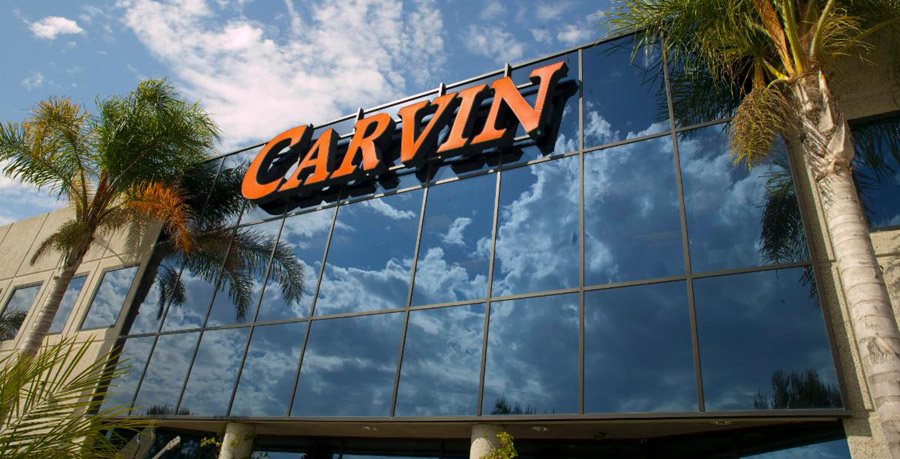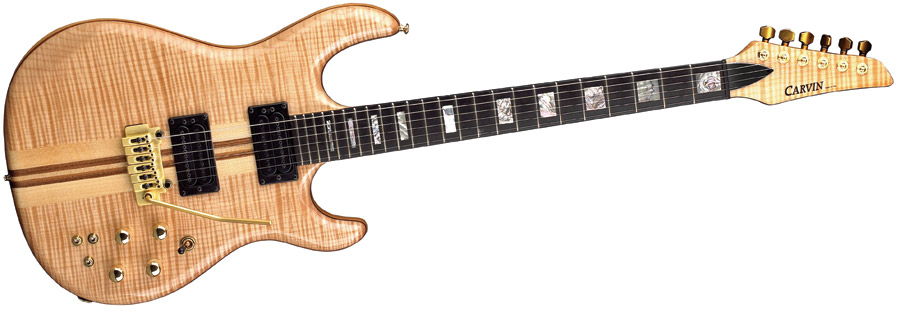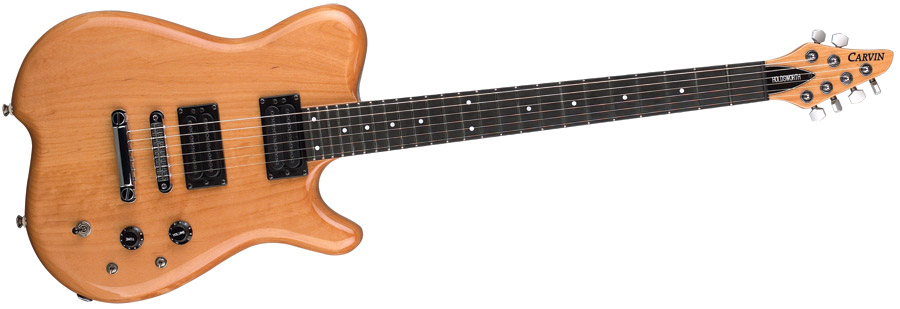
Several important changes features appeared in 1996. The most significant was the implementation of alder as the standard
body wood. Poplar had been used since 1990, and before that, it was maple. Alder had a more attractive grain than poplar,
and was lighter than maple, and it was also a superior tonewood, making it the idea standard to be used on most Carvin models.
Also of note was the new rounded body sides option, which, combined with the new alder body, made for a lighter, more comfortable instrument.
Most Carvin guitars shown from this point on would have this option, although it was just that - an option. Classic Series pickups replaced
M Series pickups as standard on most models, and Holdsworth H22 Series pickups were introduced for the Holdsworth models. A new 5-piece neck option
was also introduced, in conjunction with the Anniversary Series models.

The DC127 and DC135 continued to share a catalog page (in some of the '96 catalogs) and sported the rounded body sides in the catalog photo. Less obvious, but still present was the new alder body construction with maple neck. Also not obvious are the new pickups - in this case, the C22 humbucker (the single coils on the DC135 remained the S60 model). Other options and features remained the same as the previous year. The prices were the same as well, starting at $529 for the DC127 and $559 for the DC135. The Fall catalog showed the DC127 in tung-oiled koa with matching headstock and rounded body sides, Wilkinson tremolo and gold hardware. The DC135 was shown in Cherry Sunburst with alder neck, matching headstock and rounded body sides, chrome hardware, and Wilkinson tremolo.
The DC200 Stereo and DC400 Premium were unchanged for 1996, with the exception of the new alder wood body, new C22N and C22T pickups, and optional rounded body sides. The prices remained the same, as well. In the fall catalog, the DC200 wasn't even shown - the DC120 12-string was given it's spot. The DC120 had been always mentioned on the DC200 page, but it had been several years since one actually appeared in a catalog in anything other than an inset photo. The price on the DC200 remained constant, at $659 ($729 with the Wilkinson, $769 with the Floyd Rose). The DC120 12-string remained as $769. The DC400 dropped in price, to $889 for the base model, or $959 and $999 with the Wilkinson or Floyd Rose tremolo, respectively. The Fall catalog photo showed the DC120 in Jet Black with rounded body sides, and the DC400 in Vintage Yellow on flamed maple with Wilkinson tremolo and gold hardware.
The inset photo on the DC200 page showed the new DC400 Anniversary model (below), which was a highly upgraded DC400, with 5-piece maple/koa neck, standard
flamed maple top and matching headstock, and 3 piece alder/koa/flamed maple body. It was available as a $200 upgrade to the DC400, DC400T or DC400C.

Totally unique in design and construction was the Holdsworth H1 and H2 (below), designed by Mark Kiesel in conjunction with legendary guitarist
Allan Holdsworth. Everything about this guitar was unique - the most obvious being the radical body, which was made of alder, but was chambered
similar to a semi-hollow acoustic/electric. The neck was alder, as well, but was a set neck, so as to allow the chambering of the body. The scale
length was 25 1/2"; a half-inch longer than other models. Also new and unique was the 2 X 4 headstock shape, which was much more compact than
traditional 3 X 3 or inline headstocks. Electronics consisted on one or two Holdsworth H22 pickups (depending on the model; the H1 had a single
pickup, the H2 had a pair), with single volume and tone controls, and traditional plastic knobs. Base price on the H1 was $809, or $879 with
Wilkinson tremolo, and the H2 was $859, or $929 with Wilkinson tremolo. The standard bridge was the tune-o-matic/stopbar type that had been used
on earlier Carvins. The Fall catalog, which was the only '96 catalog they appeared in - showed the H1T in clear gloss on alder with matching headstock and black hardware, and the H2 in Emerald
Green on flamed maple with matching headstock and chrome hardware.

The SC90 also had the alder body standard in 1996, and the new rounded body sides were also available. Pickups were upgraded to the new C22N and C22T. Prices dropped a bit; the SC90 with FT6 bridge sold for $559, the SC90T with Wilkinson tremolo sold for $629, and the SC90C, with Floyd Rose tremolo, sold for $669. The HC12 hardshell case was $88, but under the current sale, could be had for free if $90 worth of options were ordered. The Fall catalog showed an SC90 in classic sunburst with alder neck and body, rounded body sides and chrome hardware.
The TL60 was almost the same as 1995, all the way down to the price and the catalog photo, but it too was also now constructed from alder, even though the catalog photo still showed older, presumably poplar models. Base price was $529, or $599 with Wilkinson tremolo. New optional pickup configurations were added, including DC127-style, DC135-style (with S60 singles or H60 stancked humbuckers), and 3 H60s. The catalog photo showed a TL60 in Jet Black with chrome hardware, M22 bridge pickup and Wilkinson tremolo, and in Tobacco Sunburst on quilted maple with gold hardware.
The AE185 got the new C22N and C22T pickups to go with the F60 acoustic pickup, but otherwise, they were unchanged for 1996. The base price of the AE185 remained $799, plus $88 for the HC12 vintage tweed hardshell case. The Fall catalog showed an AE185 in classic white with gold hardware and coil splitters and phase switch, and an AE185 with clear gloss flame koa with matching headstock, body binding, coil splitters and phase switches and black hardware.
The AC175 remained the same, including mahogany neck and body, 24-fret ebony fingerboard and ebony bridge, and the price remained
the same at $699. New for 1996 was the AC175's big brother, the AC275 (below). This model was similar to the AC175 in construction materials
and options, but had a body that was 1 1/2" thicker. Base price on the AC275 was $769. The Fall catalog showed an AC175 with natural spruce top,
gold hardware, and inline headstock. The AC275 was shown in Classic Sunburst on flamed maple with body binding and chrome hardware.

The LB20 passive bass and LB70 active bass remained the same as the past four years, and the catalog showed new versions of these basses. The only significant change was the switch back to Carvin premium tuners, due to availability problems with Sperzel. All Carvin basses in 1996 also switched to alder as the standard body wood. The base price of the LB20 dropped $10 to $569 and the LB70 remained the same as '95 at $629. The HC17 ABS case for either model was $78, and the HC18 vintage tweed hardshell case for either model was $98, although the HC17 was offered for free with $80 in options on any bass.
The BB75 saw a minor cosmetic change in '96. Gone was the engraved Bunny Brunel truss rod cover, and it was replaced with Bunny's signature on the headstock. This also took effect on the BB70. The LB75 was unchanged for this year, with the exception of the Carvin premium tuners and alder body wood. The inset photo on the BB75/LB75 page also shows another new option for Carvin basses, the 5-piece neck, in several combinations of wood, which made for a much stronger, more stable neck. Prices on the BB75 and LB75 were the same as '94, at $799 and $699. The new BB70 had a base price of $729. The HC17 ABS case for either model was $78, and the HC18 vintage tweed hardshell case for either model was $98.
The LB76 had the same change to the tuners and body wood as the other models, but was otherwise unchanged. The base price on this model stayed the same at $799, and the available cases were the same as the other models.
In celebration of Carvin's 50th anniversary, the LB76A (pictured in the catalog), the LB75A and LB70A were introduced. These were arguably the finest basses Carvin ever offered, and had features only available on this model, in addition to many "standard" features that were considered options on other models. The 3-piece body was made from alder, with a thin layer of Koa in the middle, and a flamed or optional quilted maple top. The matching headstock, midrange boost control, and 5-piece neck were standard, as was fully rounded body edges, which was a new option for LB series basses. Prices on these models were $1059 (LB70), $1129 (LB75) and $1229 (LB76). The HC17 ABS case for either model was $78, and the HC18 vintage tweed hardshell case for either model was $98.